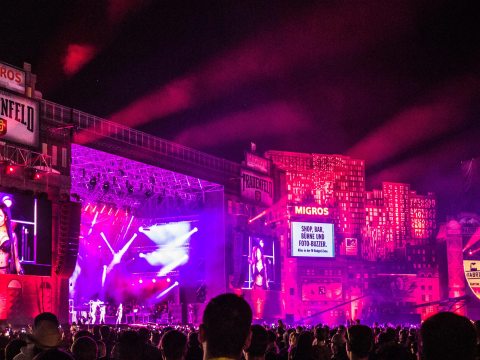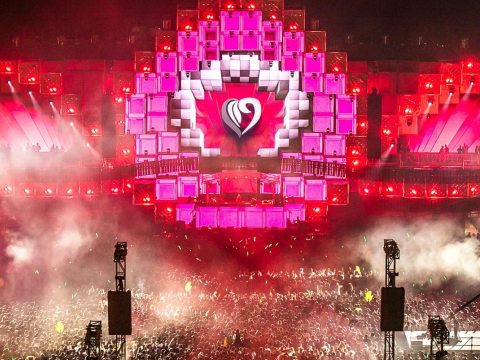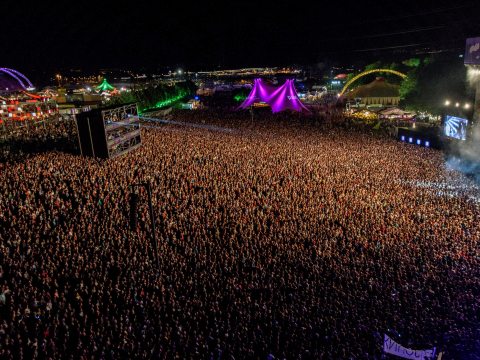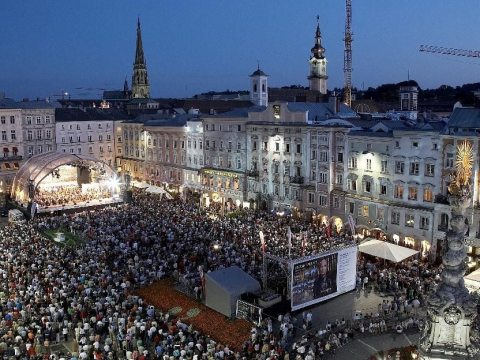The desire to immerse oneself in a carefree, euphoric world for a short time and to celebrate a mutual experience is shared by an increasing number of people. Over the past few years, many new music festivals with a wide range of styles and genres have popped up all over the world. Veteran organizers have tailored their concept more specifically to their target audience, emulating their lifestyle to a tee. But the competition is massive and loud. Ultimately, just as in any other industry, the numbers decide whether a festival is successful and will live to see another day. The concerts of the hippie movement have developed into a full-fledged business segment.
Stage Complexes as Eye-Catchers
Young events in particular need to offer their audiences a special experience if they want to establish themselves in the long-term. In addition to an attractive line-up, a unique stage design concept can set a festival apart from its competitors. The Electric Love Festival in Salzburg, Austria, for example, celebrated an impressive debut in 2013 with its towering stage design. Its sophomore event in 2014 outdid itself with a stage complex featuring a 20-meter-high rear wall and laterally integrated bars and lounges. This year, NUSSLI built the stage sets for the fledgling electronic music festival on the Salzburgring racetrack for the third time — as well as light and sound towers, the Q-Dance stage, and the Heineken Starclub. To the right and left of the 60-meter-wide main stage, the massive structure was extended by 124 and 150-meter-long VIP platforms.
Openair Frauenfeld, the largest urban/hip hop festival in Europe, also goes all out to offer visitors a complete experience. For this purpose, the organizers drafted a whole new concept with a gigantic stage city as an eye-catcher. “In fact, there’s a general trend towards open set structures that are entirely geared towards providing the audience with a show,” said Urs Gross, the project manager responsible for the structures at Openair Frauenfeld. And so, instead of the two shell stages from previous years, this year’s Openair Frauenfeld in eastern Switzerland featured a 135-meter-long skyline with four additional video screens for the acts. In addition to the north and south stages, there was also an integrated elevated platform for 60 to 100 persons offering a view that is usually reserved for bands.
“The additional time and effort required for the intermediary structure was more or less the same as for a third stage,” Gross explained. “We had to change the project timeline and complete the assembly of the stage ten days before the start of the event to give the set builders enough time to assemble the facade elements in order to create a 24-meter-high skyline.” But the audience was extremely impressed by the gigantic stage city. After a great deal of positive feedback both domestically and from abroad, the festival organizers are even considering further expanding the stage city next year.
A Wide Range of Stage Types
More than 350 festivals for all types of music genres are held each year in Germany alone. When you include events in Austria and Switzerland, this number almost doubles. The wide variety offered by these cultural events requires event structures with a maximum degree of flexibility so that each show and each act can make its full impact and captivate the audience. Of course, a city festival such as the Klassik Openair in Linz is a more subdued affair, so it has completely different stage and audio/lighting requirements than an event with thumping bass beats in the great outdoors. Modular construction systems, however, allow these highly different requirements to be met without any difficulty.
The event contractor NUSSLI has already been providing music festivals with temporary infrastructure such as stages, grandstands, light and sound towers, camera structures, platforms, and party halls since the early eighties. Since then, not only have the organizers’ requirements continually increased, but the safety regulations have also grown more stringent, and the technical equipment has advanced considerably. Today’s audio systems, for example, despite only weighing 1.5 metric tons, deliver better sound than earlier systems, which hung from PA wings and weighed a massive 20 metric tons. Due to all these trends, but also based on its own long-standing experience, NUSSLI has continued to push ahead with the development of its own construction systems and provides a variety of stage types both with and without roofs, which can be assembled in various sizes and an infinite number of variations. Over the course of a summer, the available construction material is transported constantly from festival to festival all over Europe and is constantly in use.
Openair Frauenfeld (CH)
One of the first music festivals in Europe to join the stage complex trend: This year, Openair Frauenfeld invested in a 135-meter-long ‘stage city’, which will be reassembled and possibly expanded in the coming years.
Electric Love, Salzburgring (AT)
This electronic music festival is literally exploding: In its third run this year, the organizers have already recorded three times as many visitors as the first festival in 2013.
Paléo Festival, Nyon (CH)
The Paléo Festival has made it its goal to arouse the audience’s curiosity. Hence, it constantly invites lesser known performers from all over the world and is open to all music genres, as well as circus and street performances.
Klassik Openair, Linz (AT)
The Bruckner Orchestra regaled its audience with classical music out in the open at Klassik Openair in Linz. It was located at the heart of the city on one of the most stunning ‘orchestral squares’ in Europe.






